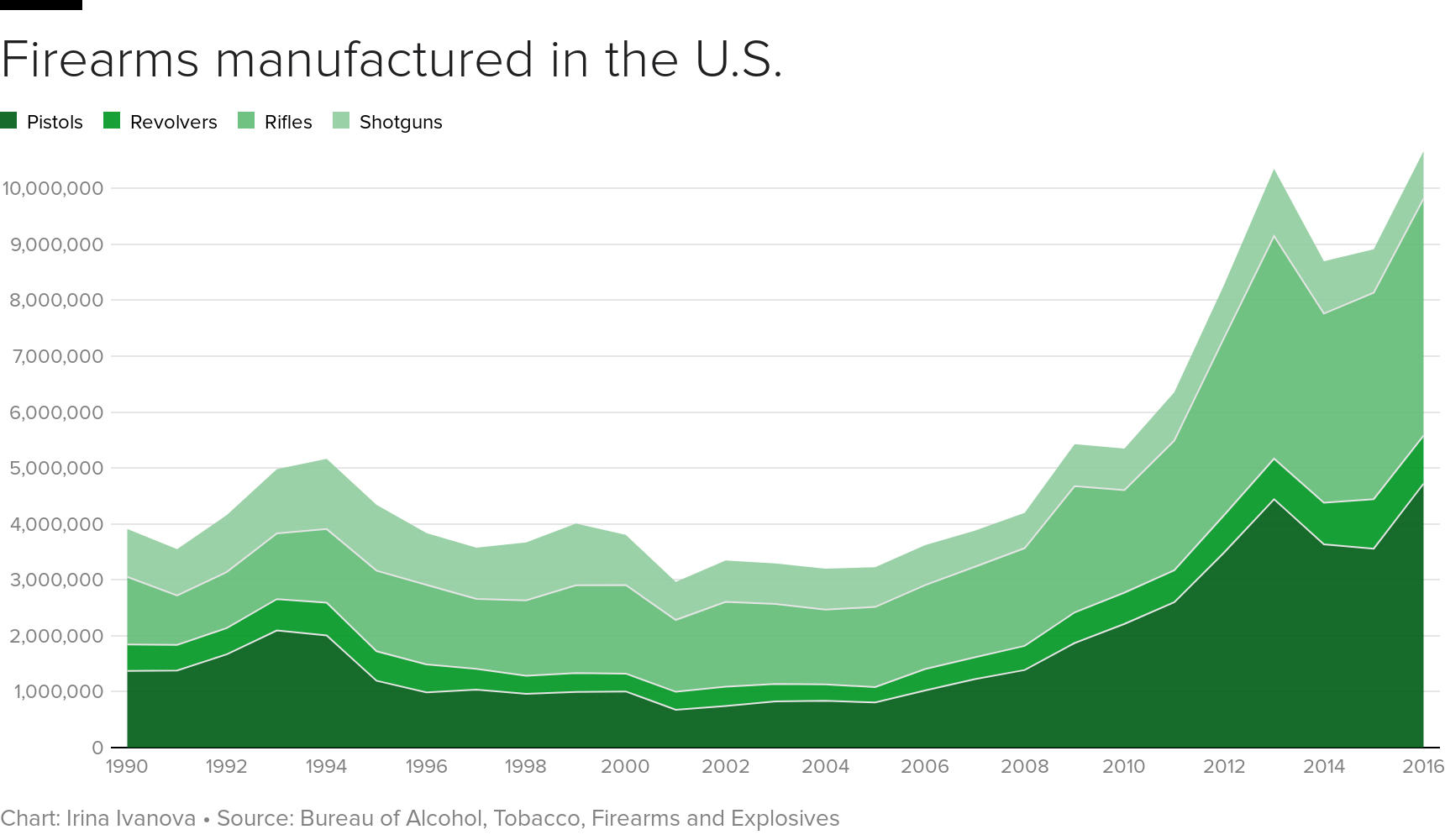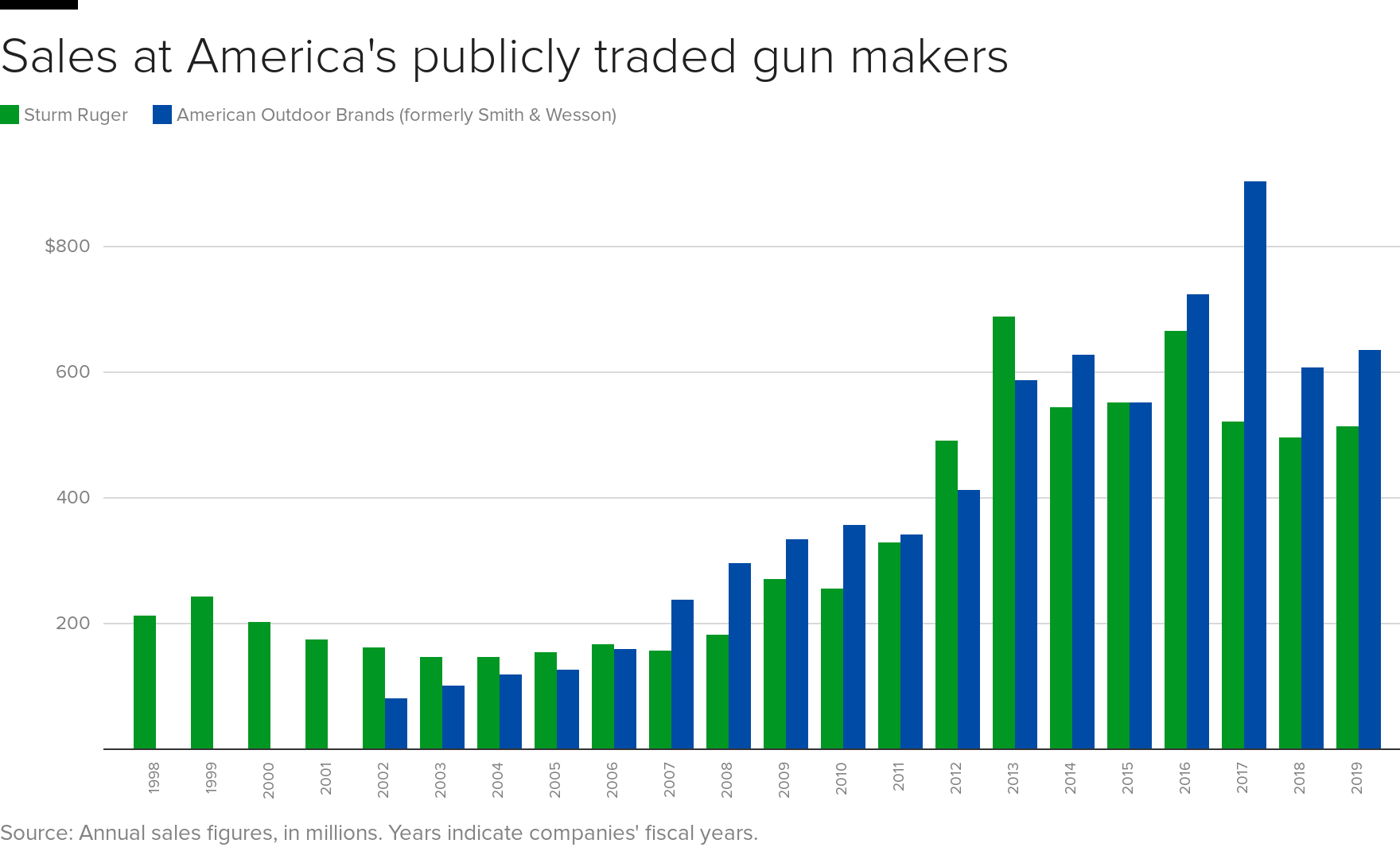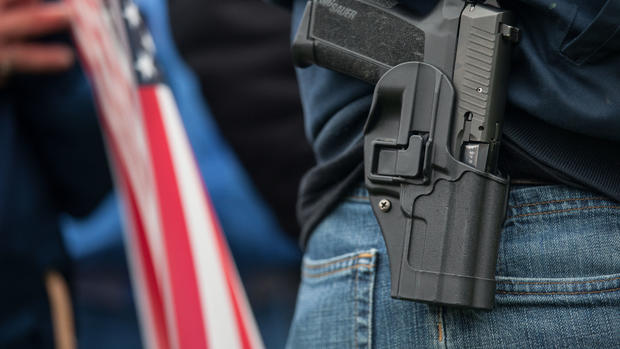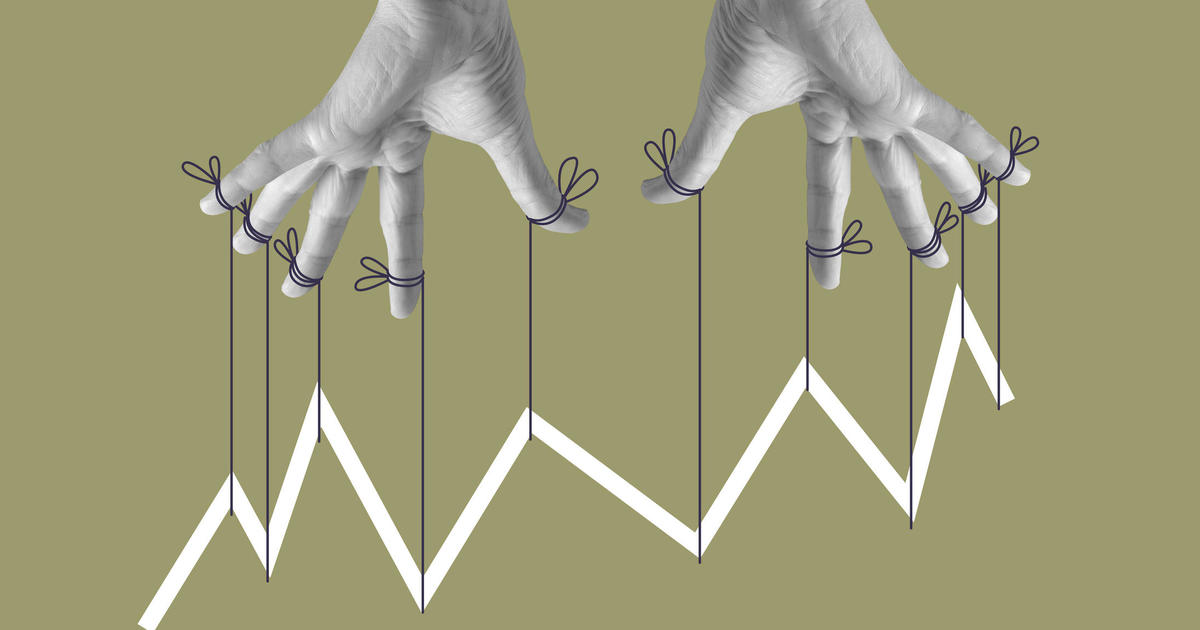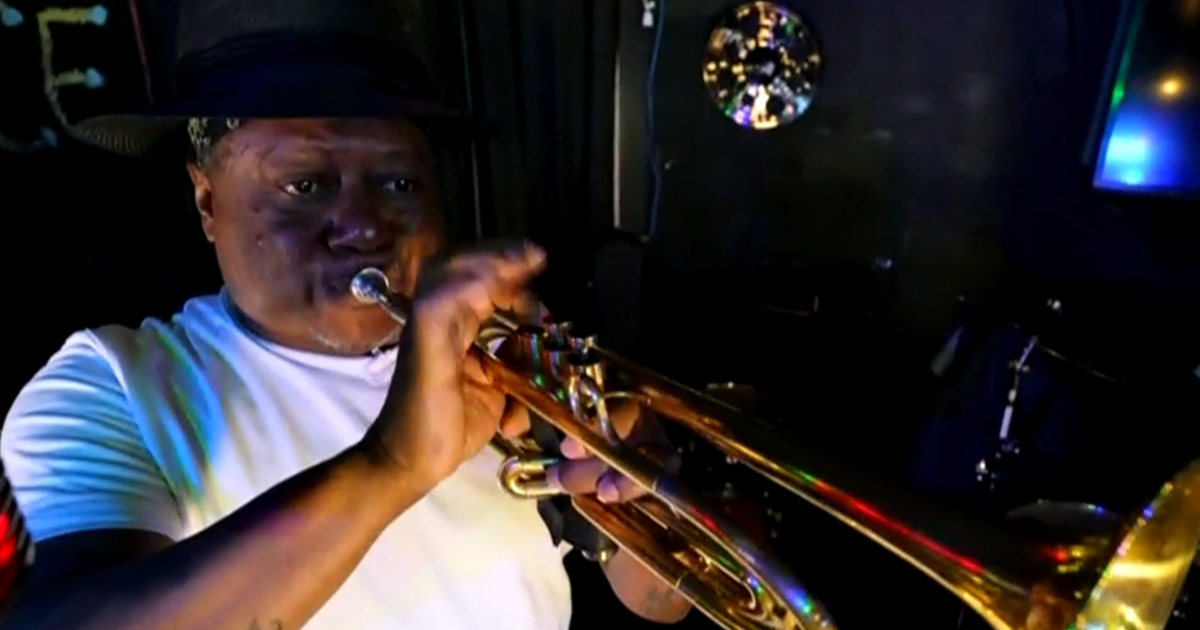How guns sales and marketing have changed 20 years after Columbine massacre
- Companies that make and sell firearms have adapted in differing ways since the Columbine killings, some with increased marketing efforts and others by exiting the business.
- Amid a volatile sales climate, the American gun industry remains lucrative, with 1 million-plus firearms still sold each month.
- The rate of gun-related deaths, adjusted for population, is at highs not seen in the U.S. since the mid-1990s.
- The rising number of guns being produced and spikes in background checks have researchers concluding that more guns are now concentrated in fewer hands.
Twenty years after Columbine, the U.S. guns and ammo business isn't exactly the same. But it is still thriving. That's the case, even though the most notorious school shooting of the modern era has been followed by seemingly nonstop gun-related bloodshed, with firearms used to kill nearly 40,000 Americans in 2017, the highest count in 50 years of tracking by the Centers for Disease Control and Prevention.
As the rate of gun-related deaths, adjusted for population, hits highs not seen since the mid-1990s, 44 percent of Americans say they personally know someone who had been shot. That exposure has led to a complex shift in attitudes toward the gun industry, which is facing an even more volatile environment in today's polarized political climate.
It's believed about three-in-10 Americans own a gun, which is a decline from years past. Yet the rising number of guns being produced and a tally of background checks have researchers concluding that more guns are now concentrated in fewer hands.
A consolidating group of manufacturers produce firearms sold by more than 60,000 licensed dealers in the U.S. They operate out of storefronts, pawnshops and homes, according to the Bureau of Alcohol, Tobacco, Firearms and Explosives. The firearms and ammunition industry accounts for as much as $52.1 billion in economic activity in the U.S., according to the National Shooting Sports Foundation, an industry trade group.
Yet as efforts to curb gun violence took hold in some state legislatures, companies that make and sell firearms have adapted in differing ways, some with increased marketing efforts and others by exiting the business. And while little has changed on the federal level, a slew of corporations have waded into this divisive issue, some by distancing themselves from working with gun manufacturers or the National Rifle Association.
Retail realities, from Walmart to Dick's Sporting Goods
One of the most powerful new dynamics is how certain corporate segments have rejected the gun industry. Take Blake Mycoskie, founder of Toms Shoes. The shooting rampage that killed 13 people at a bar and country music venue in Southern California last November prompted him to use his shoe company and brand to lobby for universal background checks. "With retail competition fiercer then ever, retailers are attempting to differentiate themselves by aligning their mission, product and marketing to convince consumers that they're a socially responsible brand," said Camilla Yanushevsky, an equities analyst with CFRA Research.
The mass shooting in Parkland, Florida,14 months ago prompted companies including Hertz and Delta Air Lines to sever ties with the NRA, the nation's largest gun-rights group. And two weeks after that Feb. 14, 2018, high school massacre left 17 dead, Walmart, the country's biggest seller of firearms and ammunition, said it would no longer sell guns or ammo to anyone under 21.
Walmart's move coincided with a more controversial one by Dick's Sporting Goods, another of the largest U.S. gun retailers, to halt sales of assault-style rifles and no longer sell guns or ammo to anyone 20 and younger.
Dick's decision was largely symbolic, given that it had already pulled the rifles from most of its 715 stores nationwide after the 2012 Sandy Hook elementary school massacre. But this time, CEO Edward Stack explicitly called for policy changes. "We hope others join us in this effort to let our kids know that their pleas are being taken seriously," he said on the company website.
The result: Dick's in March reported that same-store sales fell 3.1 percent in the 12 months ending Feb. 2 from the year-earlier period. Consumer reaction to the new gun policy was "a meaningful driver" in declining sales, Stack told analysts in an earnings conference call.
Still, Dick's efforts at downsizing its gun sales have continued. The retailer recently said it would remove firearms and other hunting products from 125 stores, and instead sell sports gear like ski apparel and batting cages.
"While guns are generally a lower-margin category, they drive foot traffic and purchases for other higher-margin sale items," said CFRA's Yanushevsky. However, Dick's decision could prove profitable as it shifts to higher-margin merchandise categories, she noted, adding: "In our view, Ed Stack's social activism has enhanced Dick's brand and reputation."
Sales shift: Up to 1.5 million gun purchases a month
Trending higher since 2005, gun sales "boomed" during the Obama administration and have since declined, said Jurgen Brauer, chief economist at Small Arms Analytics & Forecasting. He noted that overall trends are highly seasonal, with gun sales lowest in the second quarter -- April, May and June -- and highest in the year's final three months, which include the hunting season and the Thanksgiving and Christmas holidays.
In 1999, Brauer's research firm estimates nearly 8.8 million firearms sales required a background check, a tally that rose to 10 million in 2009, then hit a peak of 16.6 million in 2016. Last year, sales were estimated at 13.8 million. Monthly gun sales that in 2000 ranged from 500,000 to 1 million now tend to be between 1 million and 1.5 million each month, the economist said.
The share prices of two publicly held makers of AR-15-style weapons have fared far differently in recent months. American Outdoor Brands, which owns Smith & Wesson, has lost half its value during the past year, while Sturm Ruger has done far better, declining just a bit.
American Outdoor lost $5.7 million in its third quarter, compared with $114 million for the prior year's quarter, as CEO James Debney noted "ongoing weakness in the firearms market." Sturm Ruger, the nation's biggest supplier of hunting and assault rifles, in February reported $121 million in revenue for the fourth quarter, up from $118.2 million in the year-ago period.
At Sturm Ruger's annual meeting last May, a resolution calling for a report on the safety of its products was adopted, despite opposition from the weapons maker. Issued in February, the report included a strong rebuke of activists, saying the company's reputation as a "defender of the second amendment is not worth risking for a vague goal of improving the company's reputation among non-customers or special interest groups."
Law-abiding gun owners don't blame Smith & Wesson or other brands for the deeds of criminals or those mentally or emotionally impaired, said Sturm Ruger, which further argued that its products help defend against gun violence.
Gun makers' ad and marketing spending grows
Getting their message out is becoming more challenging for gun companies as Facebook and Google, which together account for about 60 percent of digital ad selling, have enacted restrictions. "There's still a lot of ways that firearm companies can market themselves, but they can't do everything that everyone else can," said Joshua Claflin, president of Garrison Everest, a Tennessee-based marketing firm that specializes in branding for firearms industries.
American Outdoor, for instance, spent about $56 million in marketing and public relations in 2018, about 78 percent more than it spent five years ago. The increase could be in response to the so-called "Trump slump," which operates on the theory that Americans are less likely to purchase guns when they have less fear their guns will be taken away.
Few industries have to deal with the level of variation seen in the gun industry, according to Brauer. "Industry executives really do face a challenging market environment in that the demand can zoom up 50 percent within a couple of years and then collapse by as much. This makes operations and labor force planning problematic."
Case in point is Remington Outdoor, the nation's oldest gunmaker. Facing a heavy debt load, falling sales and lawsuits tied to the Sandy Hook school shooting, Remington filed for Chapter 11 bankruptcy two days before the shooting in Parkland. It emerged from bankruptcy last May, with JPMorgan among the institutions taking a stake in exchange for forgiving $775 million in debt. Investors in Cerberus Capital Management, Remington's previous owner, had urged the private equity fund to sell Remington after its Bushmaster rifle was used in the 2012 school shooting that killed 20 children in Connecticut.
Debating the roles that lenders play (or don't play) in gun sales
At a recent hearing on Capitol Hill, JPMorgan Chase CEO Jamie Dimon defended his bank's lending to makers of weapons for police and the U.S. military, but said he would consider adopting a policy of curbing some lending to gunmakers and sellers.
In contrast, Bank of America's Brian Moynihan was criticized by Rep. Sean Duffy for his bank's recent shift in position on guns, which the Wisconsin Republican said "takes away the rights of law-abiding citizens where I live." Moynihan dismissed Duffy's assertion that his bank violates the Second Amendment by refusing to lend money to makers of assault-style weapons used for nonmilitary purposes. BofA cited 151 employees as being affected by mass shootings in its 2018 policy change.
BofA's move followed Citigroup's decision to require clients to refrain from selling guns to those who haven't passed a background check or who aren't yet 21. The nation's largest privately owned bank, First National Bank of Omaha, in February 2018 said it would stop producing credit cards for NRA members, citing customer feedback. More than a dozen companies have ended discount programs for members of the gun trade group, which has lobbied against firearms restrictions.
Louisiana also provided a contrasting example of how the debate over guns is playing out in the business world. Its bond commission last August voted to bar Citigroup and Bank of America from taking part in a bond sale, citing their "restrictive gun policies."
